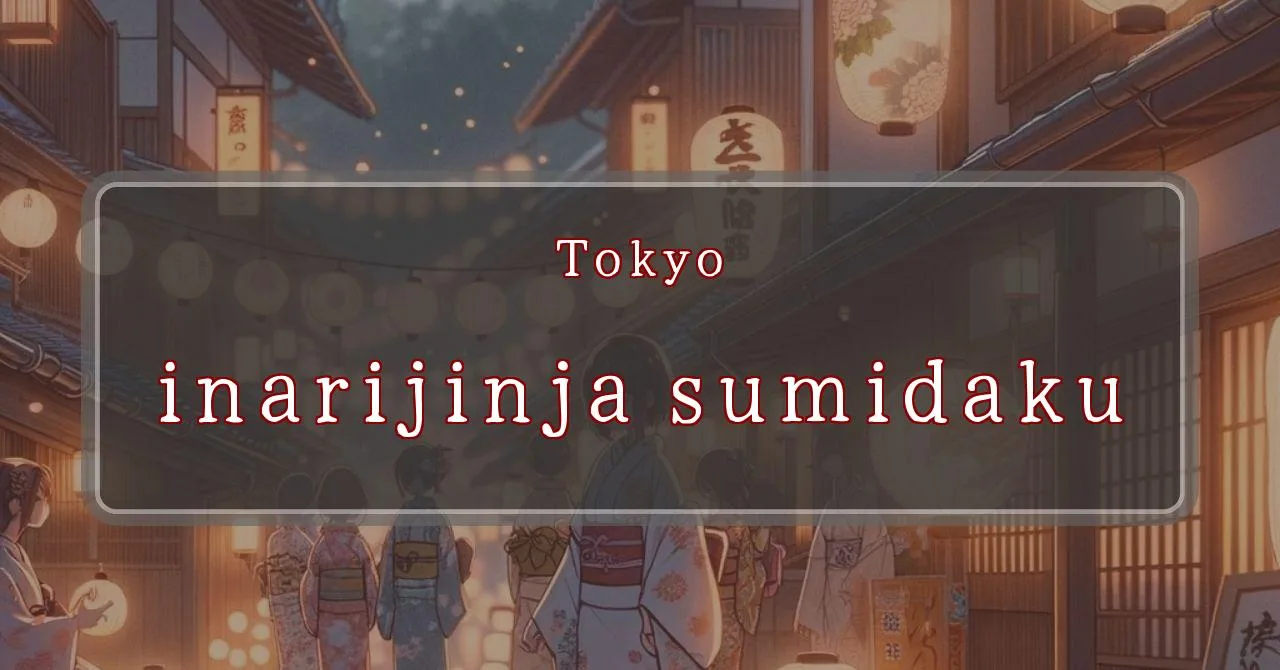Enchanting lanterns illuminate the night at Sumida Inari Shrine
Basic Information
Discover the vibrant Sumida Inari Shrine, a significant Shinto shrine located in the heart of Tokyo’s Sumida Ward. Dedicated to the deity of rice and agriculture, Inari Okami, this shrine holds a special place in the community and attracts numerous visitors throughout the year.
- Address: 13-13 墨田 4 Chome, Sumida City, Tokyo 131-0031
- Phone Number: 03-3611-7846
- Access: Easily accessible by public transportation, the shrine is a short walk from both Tobu Skytree Line’s Kanegafuchi Station and Keisei Oshiage Line’s Hachimanmae Station.
- Festival Days: June 15th, 2024
Main Events and Attractions of the Festival
The Sumida Inari Shrine Festival, held annually in Tokyo’s Sumida Ward, is a vibrant and lively event that attracts visitors from near and far. The festival features a variety of traditional and modern attractions, ensuring an enjoyable experience for all.
Mikoshi Procession
One of the main highlights of the festival is the Mikoshi Procession, where a portable shrine, or mikoshi, is carried through the streets by local residents. The mikoshi is believed to house the spirit of the deity enshrined at Sumida Inari Shrine, and the procession is a way to pay respect and seek blessings.
Manto Mikoshi
A unique feature of the Sumida Inari Shrine Festival is the Manto Mikoshi, or “lantern mikoshi.” These mikoshi are adorned with colorful lanterns and carried through the streets at night, creating a magical and enchanting atmosphere. The Manto Mikoshi is a relatively new addition to the festival, having been revived in recent years, and it has quickly become a popular attraction.
Food Stalls
No Japanese festival is complete without food stalls, and the Sumida Inari Shrine Festival is no exception. Visitors can indulge in a variety of delicious treats, from traditional Japanese dishes to modern festival favorites. From takoyaki and yakisoba to cotton candy and ice cream, there’s something for everyone to enjoy.
Cultural Performances
Throughout the festival, visitors can also enjoy a variety of cultural performances, including traditional Japanese music, dance, and theater. These performances provide a glimpse into Japan’s rich cultural heritage and add to the festive atmosphere of the event.
Blessings and Deities
Sumida Inari Shrine is dedicated to Inari Okami, the deity of rice and agriculture. Inari Okami is one of the most widely revered deities in Japan, and is believed to bestow blessings of good harvest, prosperity, and success in business. The shrine is a popular destination for people seeking blessings for their livelihoods and businesses.
- Deity: Inari Okami
- Blessings: Good harvest, prosperity, success in business
Origin and History
The origins of Sumida Inari Shrine are unclear, but it is believed to have been founded in the 16th century. The shrine was originally located in a different part of Sumida Ward, but was relocated to its current location in the 19th century. The shrine has undergone several renovations and expansions over the years, and is now a significant religious and cultural landmark in the area.
- Founded: 16th century
- Relocated: 19th century
Tips and Notes for Visitors
Here are some tips and notes for visitors to Sumida Inari Shrine:
- Festival Dates: June 15th, 2024
- Access: The shrine is a short walk from both Tobu Skytree Line’s Kanegafuchi Station and Keisei Oshiage Line’s Hachimanmae Station.
- Hours: The shrine is open daily from 9:00 AM to 5:00 PM.
- Admission: Admission to the shrine is free.
- Dress Code: Visitors are expected to dress respectfully when visiting the shrine.
- Photography: Photography is generally permitted within the shrine grounds, but it is important to be respectful of other visitors and avoid taking photos during religious ceremonies.
Parking Information
There is no dedicated parking lot for Sumida Inari Shrine. However, there are several public parking lots in the surrounding area.
- Public Parking Lots:
- Sumida Ward Office Parking Lot (5-minute walk from the shrine)
- Kanegafuchi Station Parking Lot (3-minute walk from the shrine)
- Hachimanmae Station Parking Lot (2-minute walk from the shrine)
Popular Stalls and Food Carts in Recent Years
| Type of Stall | Description |
|---|---|
| Takoyaki | A staple at Japanese festivals. Characterized by a crispy outside and a creamy inside. |
| Jaga Butter | A simple yet popular snack of hot potatoes lavishly topped with melted butter. |
| Baby Castella | Small castella cakes, sweet and fluffy treats enjoyed by children and adults alike. |
| Grilled Ayu with Salt | Fresh ayu fish grilled whole with salt, a savory taste of Japanese summer. |
| Shaapin | A unique gourmet item influenced by foreign cuisine, with a chewy skin wrapping the filling. |
| Okonomiyaki | A Japanese grilled dish where you often choose your own ingredients for a personalized flavor. |
| Cotton Candy | A fluffy, sweet snack that’s extremely popular with children. |
| Chocolate Banana | A banana coated in chocolate, a fun and visually appealing dessert. |
| Kushiyaki | Various types of ingredients skewered and grilled, an easy-to-enjoy snack. |
| Yakisoba | Fried noodles mixed with a special sauce, a fast food favorite in Japan. |



